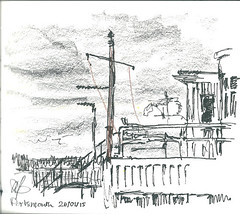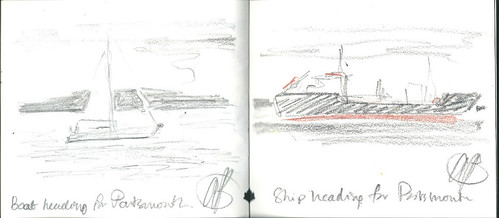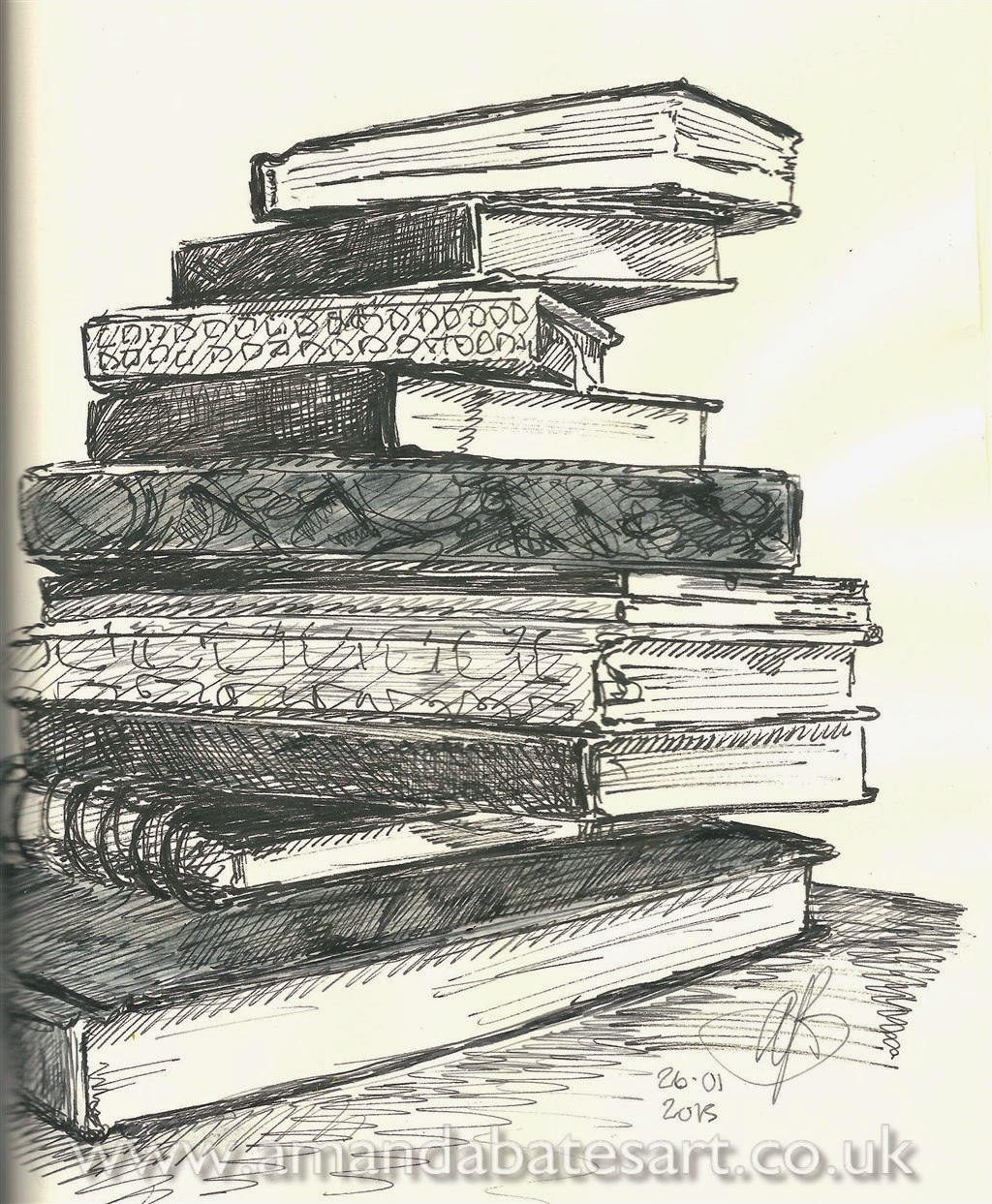Friday 30 January 2015
Prussia Cove
Another line and wash, this time from a rocky inlet in Cornwall (via a photograph).
Acrylic ink and watercolour on 300 g/m² fine grain / cold pressed (NOT) watercolour pad, 18 x 24 cm
What is a Sketch? (Part Two: Why is a Sketch?)
 |
| A rough sketch of a sketching tool (lay figure) holding a painting tool (brush) |
A sketch is rough, approximate, not polished ... but do we want our artwork, our finished, handcrafted paintings, to be polished? Do we want them to be "just like a photograph"? (My opinion on that one is a resounding, no, followed by the question, why? Because if a painting mimics a photograph, then that painting is pointless. Quite possibly very well crafted, but utterly pointless).
What are sketches for?
What do they do? Why do people make them? And what is the difference between a sketch and a doodle?Sketches can be made for their own sake; for the pleasure of doing, and, if done well, for the later pleasure of looking.
Sketches can be made to capture a visual experience for later reference. A sketch is more personal than a photograph - it captures less detail but more feeling. Perhaps, if a sketch is intended to be taken away and used in the making of a painting, it might be backed up by a photograph. Or it may be that there is no camera, or that a camera cannot be used for some reason (I once found myself on a naturist beach with a view; I left my camera in my bag, to avoid upsetting anyone, and sketched the view, which I later painted from the sketch).
Sketches also make excellent mementos - they can be annotated and adjusted on the fly to suit the occasion. A sketchbook can be used as a sort of journal.
Sketches can be made from real life, or from imagination, or from some point in between.
Sketches can be experimental; if you have an idea, you can often try it out in a sketch.
Sketches can help the artist work out what they want to paint, and how. Existing sketches can provide inspiration or a specific, required element for a painting. New sketches can rough out ideas, help work out the composition, or solve some other problem.
It is not unusual, of course, for an artist to place the key elements of a painting by sketching directly onto the canvas. Such sketches are inherently ephemeral; they get painted over.
... And what is the difference between a sketch and a doodle?
Well, a doodle falls out of your noodle (head) but you have to fetch a sketch - that is, there is little forethought or attention paid to a doodle, but a sketch is more intensive and requires thinking about or close observation of the subject.
Thursday 29 January 2015
Bridge, Bradgate Park - Line and wash
A dramatic scene from a dramatic place - Bradgate Park, Leicester. I thought I'd pick a less urban image this time around. The contrast between the bridge's dark shadows and the misty fade of the distance prompted me to use two inks; I diluted the sepia for part of the drawing.
Indian ink, acrylic ink and watercolour on 300 g/m² fine grain / cold pressed (NOT) watercolour pad, 18 x 24 cm
Indian ink, acrylic ink and watercolour on 300 g/m² fine grain / cold pressed (NOT) watercolour pad, 18 x 24 cm
St. Mary's, Melton Mowbray, from Edgerton Lodge Gardens
This is a view of the town I grew up in. From a photograph taken in February 2013, on a return visit. I used a fuller palette for this sunlit winter scene.
Acrylic ink and watercolour on 300 g/m² fine grain / cold pressed (NOT) watercolour pad, 18 x 24 cm
Acrylic ink and watercolour on 300 g/m² fine grain / cold pressed (NOT) watercolour pad, 18 x 24 cm
What is a Sketch? (Part One)
 |
| Random collection of sketches of sketching things |
A rough or unfinished drawing or painting, often made to assist in making a more finished picture.But that doesn't mean that a sketch should be hidden away. Many sketches are sufficient in themselves; others provide an insight into the creative process. Some can fall into both categories.
Sketches are likely to have one or more of the following characteristics:
- A quick drawing on paper
- A drawing in a sketchbook
- Drawn from life
- Drawn outdoors or in a public place
- Executed to test an idea
- A planning exercise, such as a compositional sketch
Any media can be used to sketch, but some are more suited than others. I'll post separately on the subject of sketching implements (part one thereof is here).
Click here for part two of What is a Sketch?
Portsmouth Dinghies - Line and Wash
I'm rather enjoying placing loose washes of colour over a line drawing made in acrylic ink. The ink is waterproof, and so I can do what I like with the waterolour. I'm trying to make a point of not "colouring in" - the idea is to create an impression of colour. I'm keeping the palette limited, too.
This is a relatively new technique for me, so the sketches are experimental. Acrylic ink is not the sort of thing that fountain pens like, so I'm using a dip pen (not much of a hardship; I like dip pens, but they aren't very good for sketching on site, because of the open bottle of ink). Unfortunately, I was a little careless and dropped a blob of ink. It's mostly disguised as shadow on the dark blue boat.
Acrylic ink and watercolour on 300 g/m² fine grain / cold pressed (NOT) watercolour pad, 18 x 24 cm
Wednesday 28 January 2015
Walking home from school
I was surprised that this worked as well as it did; I was walking and drawing at the same time... (the writing was added after getting home).
Tuesday 27 January 2015
More Burns Night Flowers
The roses were on their last legs, it seems, but the tulips are still going strong. The recent line and wash of the roses worked so well that I used a similar treatment here, albeit smaller and with different watercolours.
Digital sketch
This is a sketch once removed from life; it's based on yesterday's pen sketch, with colour added from memory. I used an Android tablet (the Tesco Hudl 2), with a stylus and the Serious Paint app.
Portsmouth
 |
| View from the café beneath the Spinnaker Tower Rotring Artpen and Derwent Line Maker with a graphite sky |
Yesterday, I went to Portsmouth to deliver some paintings for an exhibition. That done, I headed off to the waterfront to make some sketches...
Most of the drawings were done with the Derwent 0.3 Line Maker pen that I had with me as backup for the Rotring Art pen (which unaccountably clogged; since cleared and back in action). I also used a graphite stick, a selection of Derwent Drawing pencils, and Inktense (water-soluble ink pencils) for the colourful view out of the harbour.
Monday 26 January 2015
Burns Night Flowers
It is a well known fact that, if you buy an artist flowers, she will invariably paint or draw them...
This is a line and wash sketch made on loose paper with a dip pen in sepia acrylic ink, and watercolour (violet, yellow ochre and Hooker's green).
But wait! There are more...
I got a lot of mileage out of those flowers...
This is a line and wash sketch made on loose paper with a dip pen in sepia acrylic ink, and watercolour (violet, yellow ochre and Hooker's green).
But wait! There are more...
I got a lot of mileage out of those flowers...
On Sketchbooks
Sketchbooks are brilliant things. Full of direct experience, vivid images, experiments, mistakes and strokes of unreproducable genius...
This is a new series of posts intended to illustrate the possibilities of an artist's sketchbook, based upon my own work. I'm hoping to include a few links to other artist's sites as well, but we'll take it one day at a time - like a sketchbook.
Subscribe to:
Posts (Atom)




















